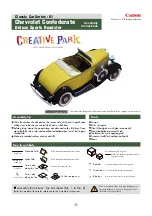
31
needed for a neat, tight furl. Even furled
sails need some seams and hems, as these
details are visible.
9. Rigging the Model with
No Sails or Furled Sails
No Sails
: Include the lines that remain
when sails are removed; i.e., clewlines,
sheets, buntlines, leechlines, and fore
and aft sail halliards and downhauls.
These are shackled together, tied off, or
secured to some other stowage point.
While they can be omitted, more lines
mean greater realism.
Furled Sails
: Attach most lines even
though the sail was proportionately
reduced or cut from Silkspan.
Stage 9 illustrates a furled sail and no
sail details for each sail group.
Installing Standing Rigging
With the exception of the bowsprit man-
ropes, standing rigging is black. Before
starting, sort lines by size, coat with
beeswax, and keep them handy. Use linen,
silk, or nylon sewing thread for seizings.
Treat this with beeswax. Keep white glue
or cyano at the ready for dabbing on a
seizing if necessary. Usually sewing
through the shroud followed by a half
hitch prevents a seizing from unraveling.
1. Shrouds
Note: The following assumes the
shrouds were rigged first, then the fore
and aft stays. However, one option is to
rig the lower shrouds and stays, then
the upper shrouds and stays.
Remember, stays go over the shrouds.
Begin the standing rigging by making
the lower shroud chain plates from
brass wire (Figure 8-1).
To set up the shrouds, make a temporary
brass wire fixture to space the deadeyes
as seizing progresses (Figure 8-2). The
fixture should be longer than the final
spacing of deadeyes. Reeving the lan-
yards will tighten the shrouds to their
final proper spacing. Make a test shroud
first to see how much it stretches.
Figure 8-2 also shows the sequence for
reeving lanyards. When looking out-
board at any deadeye, always start with
a knot in the upper left-hand deadeye
hole. Consequently, port deadeyes have
the knot aft and starboard deadeyes
have it forward. Keep an eye on the
masts. Rigging the shrouds can pull
them out of alignment.
The topmasts have deadeyes and futtock
shrouds. Topgallant shrouds have no dead-
eyes. They pass through the crosstrees and
belay to a futtock stave (Figure 8-3).
After the shrouds are in place, mount
the sheer poles. Make them from strip-
wood and paint black. Next, add the
ratlines. Figure 8-4 shows several meth-
ods. Ratlines go all the way to the top,
spaced as illustrated.
Before installing the ratlines, give them a
generous coating of beeswax. This will
help hold them in a slight downward
curve. If the ratlines tend to bow upward,
tug them gently into position. Touching
the loops with white glue or cyano will
help freeze them. Ratlines are difficult to
do if tied with clove hitches. Use half hitch-
es and avoid pulling the ratlines too tight,
thereby altering the spacing between
shrouds. The step or space between rat-
lines should be a scale 14 to 15 inches.
2. Backstays
Topmast, topgallant, and royal back-
stays are similar to shrouds, except they
have no ratlines. Rig them after the
shrouds are up. Note: Topgallant back-
stays have bullseyes, not deadeyes.
STAGE 8
Fig 8-1 Chain Plates
Fig 8-2 Spacing the Deadeyes
Solder or
not
Solder or
not
Brass
wire
Assemble, then
solder joints, or
glue with epoxy
Lower chain plates
Topgallant
1.
Pull tight
2.
Seize
Start
knot here
Tie
Lanyard
(looking outboard)
Twisted wire jig
Longer than final spacing.
Let lanyards stretch
shroud to obtain spacing
Looking Forward
at Jibboom










































